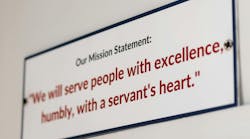One thing that I have done my entire career is ensuring that I am continually learning. You can do this by reading articles in this magazine, watching videos online or taking classes outside of your shop. Our industry is ever changing and to maintain a competitive advantage over your competition, you will have to adapt or get left behind.
Many quick lubes, for example, are moving away from a basic oil change service to more specialized full-service options. When you do this, it will take more specialized technicians and managers to properly make these transitions work. Well, what do you do to sustain and build talent from within, rather spending higher wages to bring on these talents? You adapt to a culture of coaching, not managing.
Take a moment and ask yourself two questions: Do you believe your shop has more potential than its current performance level? If the answer is yes, where’s the opportunity to harness that potential more often? Have you heard the leadership styles of “managing” and “coaching” being used interchangeably?
If you understand the difference, then you all have worked for, or with, a manager who certainly was not a coach, and therefore ineffective. In a nutshell, being a good trainer is a function of managing that every good leader of others must be able to do well.
To start, let’s consider some statistics from the Association for Talent Development. Eighty percent of the workforce who have experienced coaching say it positively impacts their work performance, productivity, communication skills, and well-being. Around 65 percent of those in a coaching culture are highly engaged.
Only 36% of organizations offer coaching-specific training to new leaders. When you can keep your people engaged, you will see upticks in speed, performance and a higher likelihood of retaining these talented employees in your pipeline. You must grow the coaching skill, as it’s not always something that is just there.
With this in mind, Here are four ways to improve your abilities in this area:
Be a Motivator, Not a Commander.
Motivating others to do something is the primary goal of coaching. Coaches show employees they care by letting them know the value in their work and helping them develop self-confidence. You must learn how to balance providing direction while remaining a motivator. This approach will create productive and engaged employees because they’ll start to care about their jobs and your shops. Teach and train them to be the coach.
Support Your Team and Make Them the Coach.
A part of training a coaching into your culture is filtering it down to the technician level. Support your team and allow them to set the standards for you. There is a very successful franchise in the Southeast that has built this into their culture. The crew takes a new employee and shows them the ins and outs of expectations, as well as the training. These employees care about their shop and those people working in it. How many of you can say that you have this in your shops? Or are they waiting for you to train this new guy in their way?
Make Them Want to do Good Work.
Unfortunately, many times, “managing” employees means solving their problems for them. Poor employees often rely on the boss to solve their problems because that’s what they’ve been trained to do, regardless of whether that training was intentional or not. Effective coaches guide their employees in their work and then get out of the way and observe. These managers trust their employees to make smart decisions. When employees feel trusted, workplace satisfaction increases, the job gets done more efficiently, and the quality of that work improves. Finally, try to create a reward program. Something as simple as a gift card, lunch or a certificate for doing good work will be appreciated.
Make Communication a Key.
Culture and climate in a workplace are key pillars to employee motivation, especially Millennials. Being heard is something important to that generation. Coaching must be a two-way communication process. You provide feedback to the employee and they can use this opportunity to also give feedback.
Employees are more likely to stay in your organization if they feel that their voice is being heard by you and their management. By integrating more coaching, you are allowing your managers more of a role in identifying employees with leadership talent.
From the keys above, focusing on coaching and supporting employees has great benefits for your organization and your employees. You will find that teaching them to be more involved in your training and leadership standards will result in better employees, less of those costly claims and leadership from the ground up, not the top down.





